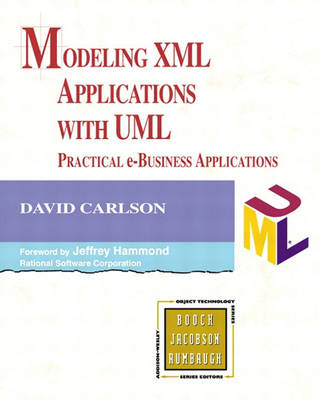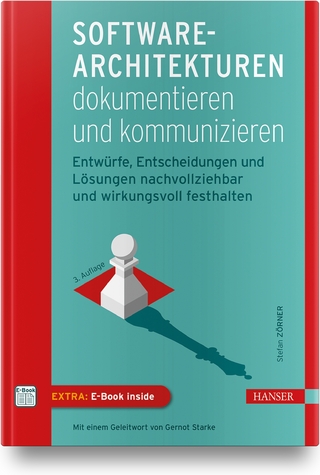
Modeling XML Applications with UML
Addison Wesley (Verlag)
978-0-201-70915-5 (ISBN)
- Titel ist leider vergriffen;
keine Neuauflage - Artikel merken
XML is rapidly becoming the standard platform for delivering e-Business information and integrating e-Business systems. XML developers desperately need mature software development processes and tools for developing effective applications. David Carlson fills the gap, showing exactly how to leverage the worldwide UML standard for modeling complex systems in advanced XML development. In Modeling XML Applications with UML, he presents the first comprehensive framework for modeling communications in any B2B software system. Carlson presents in-depth coverage of UML-based analysis, design, and modeling of XML content within e-Business environments. The book includes detailed coverage of using UML to support the creation of new XML-based B2B vocabularies and industry portals that reflect the requirements of several key stakeholder communities, including consumers, business analysts, web application specialists, system integration specialists, and content developers. Carlson presents several B2B use cases, and then decomposes them into scenarios illustrated with class diagrams, sequence diagrams, and activity diagrams showing how XML fits into an overall e-Business solution. Each chapter concludes with "steps for success" that distill UML's general principles into specific recommendations for action.
David Carlson, the CTO of Ontogenics Corporation, is an experienced researcher, developer, author, instructor, and e-business consultant. He is a frequent contributor to several technical journals, and has been a speaker at recent OOPSLA and XML conferences. In addition, he has taught graduate level courses in knowledge-based systems and computer architecture, and was a Sun-certified instructor for Java 1.0. During his 20-year career, Mr. Carlson's focus has been on creating practical applications of leading edge technology, including application modeling and XML vocabularies. 0201709155AB04062001
Foreword.
Preface.
Part I. FOUNDATIONS.
Chapter 1. Convergence of Communities.
Models for e-Business.
Stakeholder Communities.
Consumer.
Business Analyst.
Web Application Specialist.
System Integration Specialist.
Content Developer.
Road Map for This Book.
Part I. Foundations.
Part II. XML Vocabularies.
Part III. Deployment.
Steps for Success.
Chapter 2. What Is an XML Application?
HTML, XML, and XHTML.
XML Vocabularies.
XML Presentation.
Cascading Style Sheets.
XSLT Stylesheets.
Chapter Summary.
Steps for Success.
Chapter 3. What Is a UML Model?
Models and Views.
Requirements Workflow.
Use Case Diagram.
Analysis Workflow.
Activity Diagram.
Model Management Diagram.
Collaboration Diagram.
Design Workflow.
Class Diagram.
Object Diagram.
Sequence Diagram.
Component Diagram.
The Unified Process.
Chapter Summary.
Steps for Success.
Chapter 4. e-Business Integration with XML.
Use Case Analysis.
Catalog Vocabulary Requirements.
Shared Business Vocabularies.
Define Business Vocabulary.
Create XML Schema.
Validate Message.
Transform Message Content.
Process Workflow and Messaging.
Define Business Process.
Build Workflow Model.
Define Message Protocol.
Application Integration.
Create Application Classes.
Create Legacy Adapter.
Chapter Summary.
Steps for Success.
Chapter 5. Building Portals with XML.
Use Case Analysis.
Content Management.
Define Business Vocabulary.
Create Content.
Assign Content Metadata.
Portal Design.
Design Portlet.
Design Content Template.
Create Stylesheet.
Design Portal Layout.
Customize Portal Layout.
Wired and Wireless Convergence.
Chapter Summary.
Steps for Success.
Part II. XML VOCABULARIES.
Chapter 6. Modeling XML Vocabularies.
What Is a Vocabulary?
CatML Vocabulary.
Simplified Product Catalog Model.
Mapping UML to XML.
XML Metadata Interchange.
Disassembling UML Objects into XML.
UML Classes to XML Elements.
Inheritance.
UML Attributes to XML Elements.
UML Attributes to XML Attributes.
Enumerated Attribute Values.
Mapping UML Compositions.
Mapping UML Associations.
Roots and Broken Branches.
Packaging Vocabularies.
FpML Vocabulary.
UML Packages.
XML Namespaces.
Chapter Summary.
Steps for Success.
Chapter 7. From Relationships to Hyperlinks.
Expanded CatML Vocabulary.
XML Standards for Linking.
XML ID and IDREF.
Xpath.
Xpointer.
Xlink.
A Hyperlinked CatML Vocabulary.
Product Bundles.
Product Details.
Taxonomy of Categories.
Chapter Summary.
Steps for Success.
Chapter 8. XML DTDs and Schemas.
The Role of an XML Schema.
XML Document Type Definition.
DTD Attribute Declarations.
DTD Entity Declarations.
Limitations of DTDs.
W3C XML Schema.
Datatypes and Datatype Refinement.
Schemas Compatible with DTDs.
Advanced Schema Structures.
Replacement or Coexistence?
Chapter Summary.
Steps for Success.
Chapter 9. Generating XML Schemas from the UML.
Principles of Schema Generation.
Generating DTDs.
Relaxed DTDs.
Strict DTDs.
Generating W3C XML Schemas.
Relaxed Schemas.
Strict Schemas.
XLink Support.
Controlling Schema Strictness.
UML Extension Profiles.
An Extension Profile for XML.
Profile Applied to CatML.
Chapter Summary.
Steps for Success.
Part III. DEPLOYMENT.
Chapter 10. Vocabulary Transformation.
Reasons for XML Transformation.
Alternative Vocabularies.
Filtering Sensitive or Irrelevant Data.
Presenting XML Documents.
Exporting Non-XML Data.
Introduction to XSLT.
XSLT Processing Model.
Transformation Rules.
Integrating CatML with RosettaNet.
Importing a RosettaNet Dictionary.
Exporting a RosettaNet Sales Catalog.
Chapter Summary.
Steps for Success.
Bibliography.
Chapter 11. B2B Portal Presentation.
Portal Analysis Model.
Transforming XML Documents into Portlets.
A Portlet for Product Display.
A Portlet for Promotional Discounts.
Discount Transformation.
RSS Transformation.
Chapter Summary.
Steps for Success.
Chapter 12. e-Business Architecture.
Requirements for e-Business Architecture.
Deploying Web Services.
Message Protocols in XML.
Web Service Description.
Web Service Discovery.
CatX Component Architecture.
Display Portal Content.
Update Newsfeed.
Query Catalog Content.
Integrate Supplier Catalog.
Execute Currency Trade.
Query Schema Repository.
Query Service Registry.
Chapter Summary.
Steps for Success.
Part IV. APPENDIXES.
Appendix A. Reuse of FpML Vocabulary.
Trading Party Model.
Appendix B. MOF and XMI.
Meta Object Facility.
XML Metadata Interchange.
Appendix C. UML Profile for XML.
Introduction.
Stereotypes.
Bibliography Example.
References.
Index.
| Erscheint lt. Verlag | 23.4.2001 |
|---|---|
| Verlagsort | Boston |
| Sprache | englisch |
| Maße | 190 x 235 mm |
| Gewicht | 626 g |
| Themenwelt | Mathematik / Informatik ► Informatik ► Datenbanken |
| Informatik ► Software Entwicklung ► UML | |
| Mathematik / Informatik ► Informatik ► Web / Internet | |
| ISBN-10 | 0-201-70915-5 / 0201709155 |
| ISBN-13 | 978-0-201-70915-5 / 9780201709155 |
| Zustand | Neuware |
| Haben Sie eine Frage zum Produkt? |
aus dem Bereich


